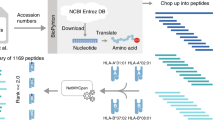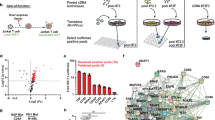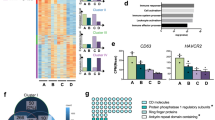Abstract
Human T-cell leukemia virus and simian T-cell leukemia virus (STLV) form the primate T-cell lymphotropic viruses group. Human T-cell leukemia virus type 1 and type 2 (HTLV-1 and HTLV-2) encode the Tax viral transactivator (Tax1 and Tax2, respectively). Tax1 possesses an oncogenic potential and is responsible for cell transformation both in vivo and in vitro. We and others have recently discovered the existence of human T-cell lymphotropic virus type 3. However, there is currently no evidence for the presence of a Tax protein in HTLV-3-infected individuals. We show that the serum of an HTLV-3 asymptomatic carrier and the sera of two STLV-3-infected monkeys contain specific anti-Tax3 antibodies. We also show that tax3 mRNA is present in the PBMCs obtained from an STLV-3-infected monkey, demonstrating that Tax3 is expressed in vivo. We further demonstrate that Tax3 intracellular localization is very similar to that of Tax1 and that Tax3 binds to both CBP and p300 coactivators. Using purified Tax3, we show that the protein increases transcription from a 4TxRE G-free cassette plasmid in an in vitro transcription assay. In all cell types tested, including transiently transfected lymphocytes, Tax3 activates its own promoter STLV-3 long terminal repeat (LTR), which contains only two Tax Responsive Elements (TREs), and activates also HTLV-1 and HTLV-2 LTRs. In addition, Tax3 also activates the NF-κB pathway. We also show that Tax3 possesses a PDZ-binding sequence at its C-terminal end. Our results demonstrate that Tax3 is a transactivator, and that its properties are more similar to that of Tax1, rather than of Tax2. This suggests the possible occurrence of lymphoproliferative disorders among HTLV-3-infected populations.
This is a preview of subscription content, access via your institution
Access options
Subscribe to this journal
Receive 50 print issues and online access
$259.00 per year
only $5.18 per issue
Buy this article
- Purchase on Springer Link
- Instant access to full article PDF
Prices may be subject to local taxes which are calculated during checkout








Similar content being viewed by others
References
Alefantis T, Barmak K, Harhaj EW, Grant C, Wigdahl B . (2003). J Biol Chem 278: 21814–21822.
Barnhart MK, Connor LM, Marriott SJ . (1997). J Virol 71: 337–344.
Blakeslee Jr JR, McClure HM, Anderson DC, Bauer RM, Huff LY, Olsen RG . (1987). Cancer Lett 37: 1–6.
Brady J, Jeang KT, Duvall J, Khoury G . (1987). J Virol 61: 2175–2181.
Calattini S, Chevalier SA, Duprez R, Bassot S, Froment A, Mahieux R et al. (2005). Retrovirology 2: 30.
Casoli C, De Lerma Barbaro A, Pilotti E, Bertazzoni U, Tosi G, Accolla RS . (2004). Blood 103: 995–1001.
Chen YM, Chen SH, Fu CY, Chen JY, Osame M . (1997). Int J Cancer 71: 196–202.
Coates SR, Harris AJ, Parkes DL, Smith CM, Liu HL, Akita RW et al. (1990). J Clin Microbiol 28: 1139–1142.
Courgnaud V, Van Dooren S, Liegeois F, Pourrut X, Abela B, Loul S et al. (2004). J Virol 78: 4700–4709.
Deng L, de la Fuente C, Fu P, Wang L, Donnelly R, Wade JD et al. (2000). Virology 277: 278–295.
Duvall JF, Kashanchi F, Cvekl A, Radonovich MF, Piras G, Brady JN . (1995). J Virol 69: 5077–5086.
Endo K, Hirata A, Iwai K, Sakurai M, Fukushi M, Oie M et al. (2002). J Virol 76: 2648–2653.
Froment A, Delaporte E, Dazza MC, Larouze B . (1993). AIDS Res Hum Retroviruses 9: 707.
Gessain A, Mauclere P, Froment A, Biglione M, Le Hesran JY, Tekaia F et al. (1995). Proc Natl Acad Sci USA 92: 4041–4045.
Giri A, Markham P, Digilio L, Hurteau G, Gallo RC, Franchini G . (1994). J Virol 68: 8392–8395.
Gitlin SD, Lindholm PF, Marriott SJ, Brady JN . (1991). J Virol 65: 2612–2621.
Goubau P, Van Brussel M, Vandamme AM, Liu HF, Desmyter J . (1994). Proc Natl Acad Sci USA 91: 2848–2852.
Grassmann R, Dengler C, Muller-Fleckenstein I, Fleckenstein B, McGuire K, Dokhelar MC et al. (1989). Proc Natl Acad Sci USA 86: 3351–3355.
Grossman WJ, Kimata JT, Wong FH, Zutter M, Ley TJ, Ratner L . (1995). Proc Natl Acad Sci USA 92: 1057–1061.
Guo HG, Wong-Stall F, Gallo RC . (1984). Science 223: 1195–1197.
Harrod R, Tang Y, Nicot C, Lu HS, Vassilev A, Nakatani Y et al. (1998). Mol Cell Biol 18: 5052–5061.
Hirata A, Higuchi M, Niinuma A, Ohashi M, Fukushi M, Oie M et al. (2004). Virology 318: 327–336.
Hisada M, Okayama A, Shioiri S, Spiegelman DL, Stuver SO, Mueller NE . (1998). Blood 92: 3557–3561.
Hunsmann G, Schneider J, Bayer H, Jurkiewicz E, Yamamoto N . (1984). Princess Takamatsu Symp 15: 109–118.
Iwanaga Y, Tsukahara T, Ohashi T, Tanaka Y, Arai M, Nakamura M et al. (1999). J Virol 73: 1271–1277.
Jeang KT, Giam CZ, Majone F, Aboud M . (2004). J Biol Chem 279: 31991–31994.
Kashanchi F, Duvall JF, Kwok RP, Lundblad JR, Goodman RH, Brady JN . (1998). J Biol Chem 273: 34646–34652.
Kwok RP, Laurance ME, Lundblad JR, Goldman PS, Shih H, Connor LM et al. (1996). Nature 380: 642–646.
Lemasson I, Nyborg JK . (2001). J Biol Chem 276: 15720–15727.
Lindholm PF, Marriott SJ, Gitlin SD, Brady JN . (1991). J Biochem Biophys Methods 22: 233–241.
Liu HF, Vandamme AM, Van Brussel M, Desmyter J, Goubau P . (1994). Lancet 344: 265–266.
Lu H, Pise-Masison CA, Fletcher TM, Schiltz RL, Nagaich AK, Radonovich M et al. (2002). Mol Cell Biol 22: 4450–4462.
Mahieux R, Gessain A . (2003). Rev Clin Exp Hematol 7: 336–361.
Mahieux R, Ibrahim F, Mauclere P, Herve V, Michel P, Tekaia F et al. (1997). J Virol 71: 1317–1333.
Mauclere P, Gessain A, Garcia-Calleja JM, Le Hesran JY, Salla R, Rehle T et al. (1993). Aids 7: 1394–1395.
Mauclere P, Le Hesran JY, Mahieux R, Salla R, Mfoupouendoun J, Abada ET et al. (1997). J Infect Dis 176: 505–509.
Mboudjeka I, Zekeng L, Yamashita M, Takehisa J, Ido E, Miura T et al. (1997). Jpn J Cancer Res 88: 619–624.
Meertens L, Chevalier S, Weil R, Gessain A, Mahieux R . (2004a). J Biol Chem 279: 43307–43320.
Meertens L, Gessain A . (2003). J Virol 77: 782–789.
Meertens L, Mahieux R, Mauclere P, Lewis J, Gessain A . (2002). J Virol 76: 259–268.
Meertens L, Pise-Masison C, Quere N, Brady J, Gessain A, Mahieux R . (2004b). Oncogene 23: 5447–5458.
Meertens L, Shanmugam V, Gessain A, Beer BE, Tooze Z, Heneine W et al. (2003). J Gen Virol 84: 2723–2727.
Miyoshi I, Yoshimoto S, Fujishita M, Taguchi H, Kubonishi I, Niiya K et al. (1982). Lancet 2: 658.
Nerrienet E, Meertens L, Kfutwah A, Foupouapouognigni Y, Ayouba A, Gessain A . (2004). J Gen Virol 85: 25–29.
Nerrienet E, Meertens L, Kfutwah A, Foupouapouognigni Y, Gessain A . (2001). J Gen Virol 82: 2973–2977.
Nicot C, Dundr M, Johnson JM, Fullen JR, Alonzo N, Fukumoto R et al. (2004). Nat Med 10: 197–201.
Nourry C, Grant SG, Borg JP . (2003). Sci STKE 2003: RE7.
Pise-Masison CA, Brady JN . (2005). Front Biosci 10: 919–930.
Pise-Masison CA, Mahieux R, Radonovich M, Jiang H, Duvall J, Guillerm C et al. (2000). AIDS Res Hum Retroviruses 16: 1669–1675.
Pozzatti R, Vogel J, Jay G . (1990). Mol Cell Biol 10: 413–417.
Ross TM, Pettiford SM, Green PL . (1996). J Virol 70: 5194–5202.
Rousset R, Fabre S, Desbois C, Bantignies F, Jalinot P . (1998). Oncogene 16: 643–654.
Scoggin KE, Ulloa A, Nyborg JK . (2001). Mol Cell Biol 21: 5520–5530.
Slattery JP, Franchini G, Gessain A . (1999). Genome Res 9: 525–540.
Smith MR, Greene WC . (1990). Genes Dev 4: 1875–1885.
Takemura T, Yamashita M, Shimada MK, Ohkura S, Shotake T, Ikeda M et al. (2002). J Virol 76: 1642–1648.
Van Brussel M, Goubau P, Rousseau R, Desmyter J, Vandamme AM . (1996). J Gen Virol 77(Part 2): 347–358.
Van Brussel M, Goubau P, Rousseau R, Desmyter J, Vandamme AM . (1997). J Virol 71: 5464–5472.
Van Brussel M, Salemi M, Liu HF, Goubau P, Desmyter J, Vandamme AM . (1999). Rev Med Virol 9: 155–170.
Van Dooren S, Salemi M, Pourrut X, Peeters M, Delaporte E, Van Ranst M et al. (2001). J Virol 75: 11939–11941.
Van Dooren S, Shanmugam V, Bhullar V, Parekh B, Vandamme AM, Heneine W et al. (2004). J Gen Virol 85: 507–519.
Watanabe M, Ohsugi T, Shoda M, Ishida T, Aizawa S, Maruyama-Nagai M et al. (2005). Blood 106: 2462–2471.
Wolfe ND, Heneine W, Carr JK, Garcia AD, Shanmugam V, Tamoufe U et al. (2005). Proc Natl Acad Sci USA 102: 7994–7999.
Younis I, Khair L, Dundr M, Lairmore MD, Franchini G, Green PL . (2004). J Virol 78: 11077–11083.
Acknowledgements
This work was supported by a grant from l'Association de Recherche sur le Cancer (ARC #4781) to RM and fellowships from le Ministère de la Recherche to SAC and CANAM and Pasteur Weizmann to LM. It was also partially supported by grants from the George Washington University REF funds to AA and FK; NIH grants AI44357, AI43894 and 13969 to FK. RM is supported by INSERM. We thank Dr P Jalinot for the generous gift of the pSGF-cl.15 plasmid, Dr P Mauclère (Centre Pasteur du Cameroun), Dr J Fagot (CNRS) for their help in obtaining the monkeys blood samples and Dr A Froment (IRD) for his help in obtaining the blood sample of the HTLV-3-infected individual.
Author information
Authors and Affiliations
Corresponding author
Rights and permissions
About this article
Cite this article
Chevalier, S., Meertens, L., Pise-Masison, C. et al. The tax protein from the primate T-cell lymphotropic virus type 3 is expressed in vivo and is functionally related to HTLV-1 Tax rather than HTLV-2 Tax. Oncogene 25, 4470–4482 (2006). https://doi.org/10.1038/sj.onc.1209472
Received:
Revised:
Accepted:
Published:
Issue Date:
DOI: https://doi.org/10.1038/sj.onc.1209472
Keywords
This article is cited by
-
Human T-cell lymphotropic virus type 1 and its oncogenesis
Acta Pharmacologica Sinica (2017)
-
Conference Highlights of the 16th International Conference on Human Retrovirology: HTLV and Related Retroviruses, 26–30 June 2013, Montreal, Canada
Retrovirology (2014)
-
Identification of a novel motif responsible for the distinctive transforming activity of human T-cell leukemia virus (HTLV) type 1 Tax1 protein from HTLV-2 Tax2
Retrovirology (2009)
-
Genetic characterization of the complete genome of a highly divergent simian T-lymphotropic virus (STLV) type 3 from a wild Cercopithecus mona monkey
Retrovirology (2009)
-
Ancient, independent evolution and distinct molecular features of the novel human T-lymphotropic virus type 4
Retrovirology (2009)



